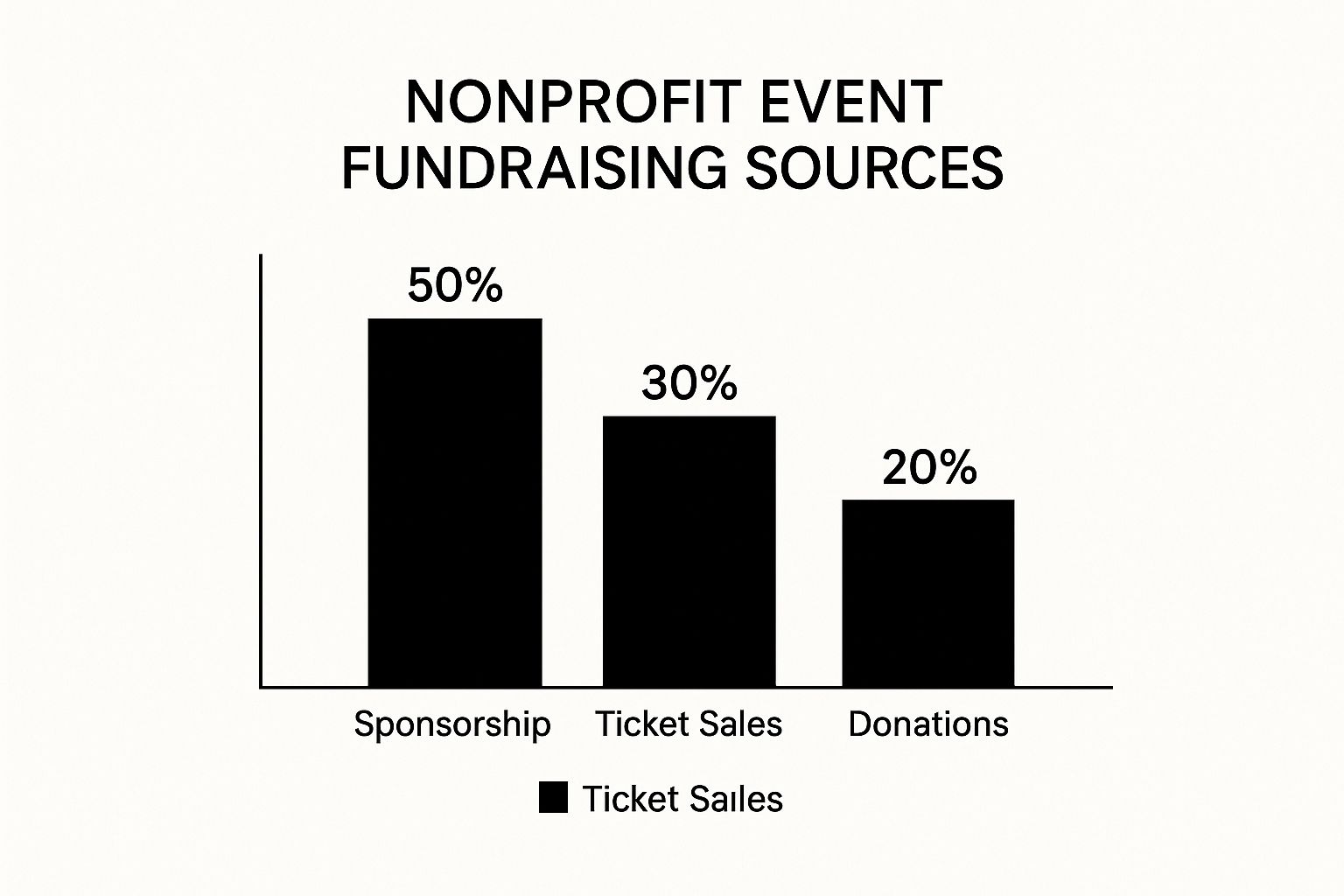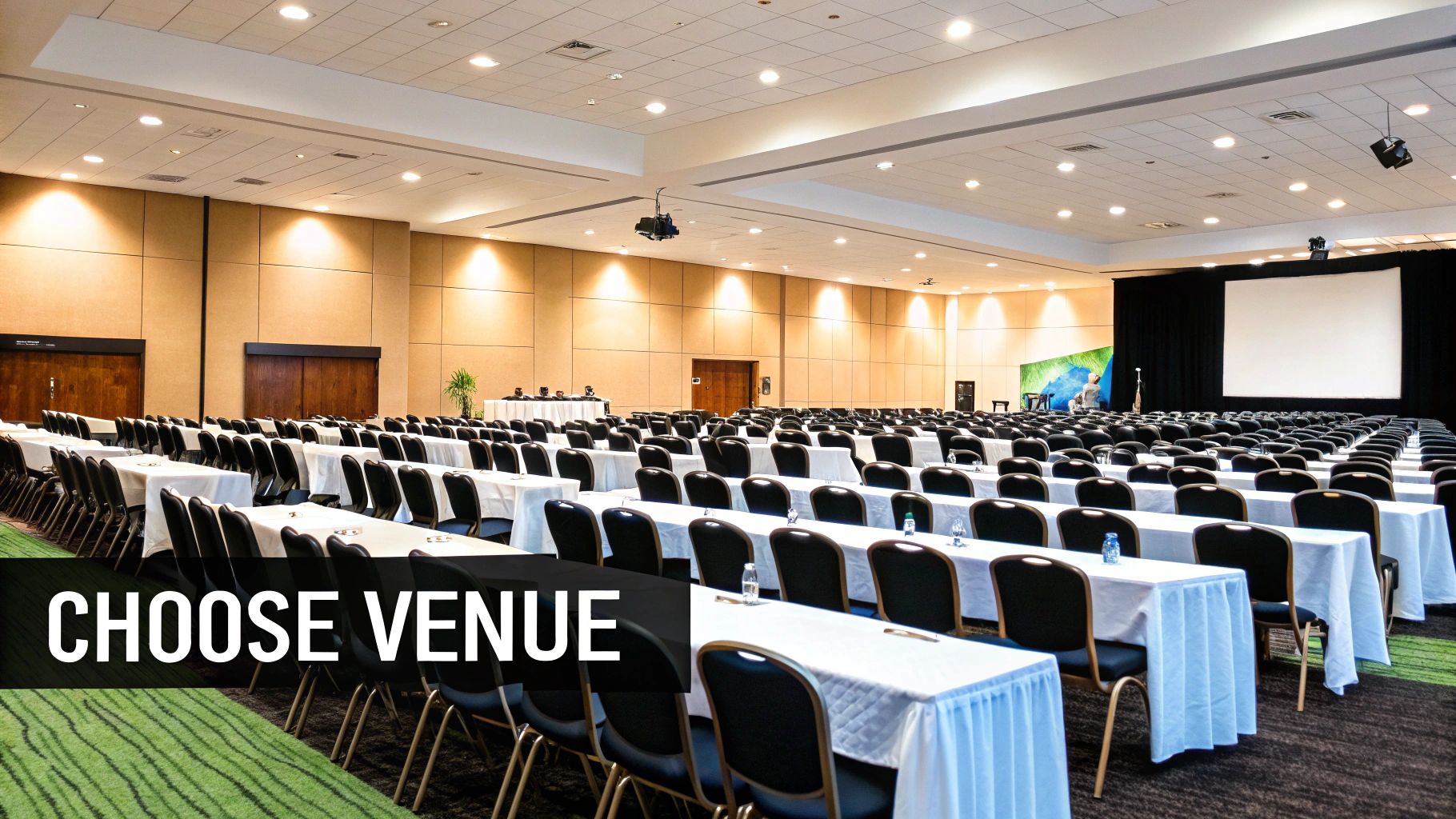Setting Goals That Actually Matter (Not Just Revenue)
Nonprofit event planning often revolves around a single, sometimes intimidating, metric: revenue. However, fixating solely on the money raised can obscure other vital aspects of a truly successful event. While a healthy bottom line is essential, it shouldn't be the only measure of success. For example, some of the most effective nonprofit events prioritize building lasting relationships and fostering community engagement, with fundraising naturally following.
This shift in perspective is crucial because thriving nonprofits recognize that their events are more than just fundraising tools. They are valuable opportunities to connect with their community, strengthen their brand, and further their mission.
Defining Measurable Objectives
So, how can you define measurable objectives beyond just the final check amount? Begin by aligning your event goals with your overall organizational mission. If your mission is to provide educational resources to underserved communities, your event goals might involve raising awareness about educational disparities or recruiting new volunteer tutors. These goals, while not directly tied to revenue, contribute significantly to the long-term success of your mission.
Building Realistic Timelines and KPIs
Next, consider building realistic timelines that your team can actually achieve. Ambitious goals are admirable, but unattainable ones can quickly demoralize your team and hinder progress. This is directly related to establishing Key Performance Indicators (KPIs) that are easy to understand and track. For instance, instead of simply aiming for a specific dollar amount, track the number of new donor relationships formed or the increase in website traffic after the event. These KPIs offer a more detailed understanding of your event's true impact.
Balancing Multiple Goals
Finally, how can you balance multiple objectives without losing focus? Prioritize. Identify the two or three most critical goals for your event and allocate resources accordingly. This prioritization helps streamline your efforts and prevents your team from being spread too thin.
The nonprofit sector relies heavily on events for fundraising and community engagement. Common examples include charity runs, auctions, and galas. According to event industry statistics, the global events market was valued at approximately $736.8 billion in 2021 and is projected to reach $2.5 trillion by 2035. This projected growth highlights the increasing importance of events across various sectors, including nonprofits, and underscores the importance of strategic nonprofit event planning. By setting goals that genuinely matter, your nonprofit can create events that are not only financially successful but also deeply impactful.
Smart Budgeting That Protects Your Mission

A well-structured budget is essential for successful nonprofit event planning. Without one, even the best events can face financial challenges, impacting your organization's resources and reputation. Careful planning and management are crucial for protecting your mission.
Initial Cost Estimates and Vendor Negotiations
Start by creating realistic initial cost estimates. Just as a detailed blueprint guides construction, a comprehensive budget serves as your event's roadmap, managing spending and preventing surprises. This involves researching vendor costs, venue fees, and marketing expenses to get a realistic overview.
Negotiating with vendors who understand the needs of nonprofits is also key. Many are willing to offer discounts or in-kind donations to support a good cause.
Creating Multiple Budget Scenarios
Next, develop multiple budget scenarios. Consider a best-case scenario with high sponsorships, a moderate scenario reflecting initial projections, and a worst-case scenario accounting for unforeseen costs. These scenarios offer flexibility and adaptability. Effective nonprofit budgeting requires informed choices. Learn more about data-driven decision making.
Avoiding Common Budget Traps and Tracking Expenses
Experienced event planners anticipate potential budget pitfalls, just as hikers prepare for challenging terrain. One common trap is underestimating hidden costs like permits or insurance.
Failing to account for these can strain resources. Meticulous expense tracking is vital. Think of your budget as a compass, guiding you towards your financial targets. Regularly monitoring actual expenses against your budget helps identify and address any overspending. Check out our guide on How to master website design costs for tips on optimizing web design budgets.
Contingency Funds and Financial Reporting
Contingency funds are a safety net for unexpected costs, like a reserve parachute. They provide essential backup when the unforeseen occurs. Transparent financial reporting demonstrates accountability to donors and board members.
A clear financial report narrates your event's financial journey. This fosters trust and confidence in your organization's management. By implementing these smart budgeting strategies, you protect your mission and ensure long-term financial sustainability.
Measuring Success Beyond The Check Total
Nonprofit event planning is about more than just the bottom line. While the final fundraising total is important, it doesn't paint the complete picture of a truly successful event. True impact comes from blending quantitative metrics (like dollars raised) with qualitative metrics (like community engagement). This means evaluating the long-term effects on your mission.

This chart breaks down typical fundraising sources. Sponsorship brings in 50%, ticket sales contribute 30%, and individual donations make up 20%. Strong sponsorships are clearly key, but a diversified income stream is also important. Many nonprofits struggle to measure return on investment (ROI) for their events. Across the industry, only 23% of companies effectively track event ROI. Find more detailed statistics here. This is even harder for nonprofits, whose events often have multiple goals, like fundraising and community engagement.
Evaluating Attendee Satisfaction and Donor Retention
Gathering feedback after an event is critical for future planning. Post-event surveys, feedback forms, and monitoring social media can provide invaluable insights into attendee satisfaction.
Donor retention is also crucial for long-term stability. Analyzing repeat donations, pledge renewals, and ongoing engagement helps you understand how effectively your event is building lasting donor relationships.
Building Lasting Relationships and Presenting Compelling Reports
Think of your donors like seeds that need nurturing. Successful nonprofits cultivate event attendees into dedicated, long-term supporters. This means focusing on genuine connection and demonstrating the impact of their contributions.
This leads to the importance of strong post-event reports. These reports should go beyond just the numbers. They should share stories, highlight lives changed, and showcase progress towards your mission. Read also: How to master campaign performance measurement.
The following table provides a comparison of key metrics to measure the success of your event. It explores both quantitative and qualitative measures, and their relative importance over different timeframes.
Event Success Metrics Comparison Table
A comprehensive comparison of different success metrics for nonprofit events, showing quantitative vs qualitative measures and their relative importance.
| Metric Type | Measurement Method | Timeline | Importance Level |
|---|---|---|---|
| Funds Raised | Total donations, sponsorships, ticket sales | Immediate/Short-term | High |
| Attendee Satisfaction | Post-event surveys, feedback forms | Short-term | Medium |
| Donor Retention | Repeat donations, pledge renewals | Long-term | High |
| Media Mentions | Press coverage, social media buzz | Short-term/Medium-term | Medium |
| Community Engagement | Volunteer sign-ups, social media interactions | Long-term | High |
| Brand Awareness | Website traffic, social media followers | Medium-term/Long-term | Medium |
This table reveals that while immediate financial success is important, long-term metrics like donor retention and community engagement are equally critical for a thriving nonprofit.
By focusing on the broader impact, you can move beyond just dollars raised and build a truly engaged and supportive community around your cause.
Corporate Partnerships That Feel Authentic

Transactional sponsorships are a thing of the past. Today, companies want real partnerships that benefit everyone involved. This means nonprofits need to change how they plan events, focusing on authentic corporate partnerships. Smart nonprofits are looking for companies that share their values.
This creates long-term relationships that are good for both the nonprofit and the business.
Identifying Potential Corporate Allies
Finding the right corporate partners takes research and strategy. It's about finding a match based on shared values and goals. Start by researching companies that have supported similar causes.
Also, consider businesses whose customers match your donors. This opens up opportunities for joint marketing and outreach. You might be interested in: How to master community engagement strategies.
Crafting Compelling Partnership Proposals
Once you've found potential partners, a strong proposal is key. It should clearly show the benefits for both sides, highlighting the shared value and potential impact.
For example, instead of just asking for money, show how the partnership will improve the company's image, offer chances for employees to volunteer, and generate positive PR.
Maintaining Long-Term Relationships
A successful corporate partnership needs constant care and attention. Regular communication, honest reporting, and celebrating wins together are important for building trust and a strong bond.
This means acknowledging the contributions of both partners.
Leveraging The Growing Corporate Event Market
The corporate event world is booming, and this is great news for nonprofits. The global corporate event market is expected to grow at a CAGR of 10.61% between 2023 and 2029. Explore this topic further.
This means more companies are investing in events, leading to more chances for partnerships and sponsorships with nonprofits.
Innovative Partnership Models
Traditional sponsorships are just the start. Cause-related marketing campaigns, joint fundraising, and employee volunteer programs are just a few examples of innovative partnerships.
These can create a deeper connection between the company and the nonprofit's mission. By using these strategies, nonprofits can turn event planning into a way to build lasting, mutually beneficial relationships with corporate partners.
Marketing That Moves People To Action

Successful nonprofit events don't just happen; they require careful planning and impactful marketing. This means understanding your audience and what motivates them. It's about crafting a message that truly inspires action, going beyond simple announcements to generate genuine excitement and support.
Crafting Compelling Event Stories
Don't just announce your event; tell its story. People connect with narratives. Frame your event around its purpose and the difference it will make.
Showcase the positive impact on individuals or the community challenge you're addressing. This emotional connection encourages audience engagement and inspires them to get involved.
Reaching Your Audience: Volunteers and Digital Tools
Your volunteer network offers a powerful marketing advantage. These passionate individuals can authentically share your message within their own networks.
Digital tools provide cost-effective ways to extend your reach. Social media platforms like Facebook, Instagram, and Twitter combined with email marketing and online event listings, can significantly expand your audience without breaking the bank. For more insights on digital marketing, check out this helpful article on How to master small business marketing strategies.
Creating Effective Communication: Timelines and Messaging
Building momentum is crucial for event success. A well-planned communication timeline creates anticipation and excitement.
Consider releasing teaser information, offering behind-the-scenes glimpses, and highlighting speakers or performers. Remember to tailor your message to different segments of your audience. Understanding their unique interests allows you to craft resonant messages, maximizing engagement and participation.
Building Buzz and Driving Action: Generating Excitement
Creating buzz generates anticipation and excitement. Engage with your audience on social media. Encourage them to share event details and partner with local media.
Early bird discounts, contests, and interactive online content are great ways to generate conversations about your event. This increased visibility can lead to higher ticket sales, more sponsorships, and increased donations.
The following table shows the effectiveness of different marketing channels for nonprofit events:
Nonprofit Event Marketing Channels Effectiveness
Analysis of different marketing channels showing cost, reach, and engagement rates for nonprofit events
| Marketing Channel | Cost Level | Reach Potential | Engagement Rate | Best Use Case |
|---|---|---|---|---|
| Social Media (Organic) | Low | Medium | Medium-High | Building community, sharing updates, and driving traffic to event pages |
| Social Media (Paid) | Medium | High | Medium | Reaching new audiences, promoting specific event aspects, increasing ticket sales |
| Email Marketing | Low | Medium | Medium-High | Sharing personalized messages, promoting early bird discounts, and sending event reminders |
| Public Relations/Media Outreach | Low-Medium | High | Medium | Generating media coverage, building credibility, and reaching a wider audience |
| Volunteer Networks | Low | Medium | High | Spreading the word through personal connections, generating authentic enthusiasm |
| Website/Event Landing Page | Low-Medium | Medium | Medium | Providing detailed event information, facilitating registration, and collecting donations |
This table summarizes the cost, reach potential, and engagement rate of various marketing channels. As shown, leveraging a mix of these channels can maximize your event's impact.
Nonprofit event planning is more than logistics. Effective marketing connects your event with the right people, resonates with their values, and inspires action, ultimately fulfilling your mission.
Day-Of Execution That Actually Goes Smoothly
Successfully planning a non-profit event relies heavily on seamless execution. Making the day look effortless actually takes a lot of careful planning behind the scenes. This means putting systems in place to manage all the logistics, from the initial venue selection to coordinating activities on the day itself.
Venue Selection and Vendor Management
Choosing the right venue can have a big impact on your budget. Seek out venues that offer discounts for non-profits. You could also think outside the box and consider unconventional spaces like community centers or local parks. This can free up funds for other critical event needs.
Effective vendor management is also essential. Make sure you confirm every single detail in writing. This includes delivery times, set-up requirements, and anything else pertinent to their services. This proactive approach helps minimize misunderstandings and ensures a smooth process.
Volunteer Coordination and Timeline Development
Volunteers are often the backbone of non-profit events. Clearly defined roles and responsibilities are essential for a successful event. Providing sufficient training and showing appreciation for their contribution will keep your volunteer team motivated and productive.
A detailed timeline, encompassing set-up, event activities, and post-event breakdown, is key for keeping everyone on the same page. This roadmap will help you avoid delays and ensure smooth transitions throughout the day. Consider checking out resources on managing project scope creep to help avoid timeline issues.
Contingency Planning and Event Management Tools
Even with the best-laid plans, unexpected issues can still pop up. Having contingency plans in place for various scenarios – from weather emergencies and technical difficulties to speaker cancellations – can minimize disruptions and keep your event on track.
Technology can also streamline many aspects of event management. Event planning software, online ticketing platforms, and communication tools like Slack can help manage registration, track attendance, and communicate efficiently with attendees. For nonprofits looking to broaden their reach, social media management tools can be invaluable.
Post-Event Evaluation
Finally, post-event evaluation is crucial for improving future events. Gathering feedback from attendees, volunteers, and vendors can help identify what worked well and highlight areas for improvement. Use this information to refine your strategy for upcoming events.
By following these strategies, you can transform potentially chaotic event execution into a well-organized operation. This maximizes your impact and creates a truly memorable experience. This attention to detail elevates your event, taking it from good to truly great. This careful approach is a cornerstone of successful non-profit event planning.
Key Takeaways
Nonprofit event planning is more than simply arranging a fundraiser; it's about creating a sustainable system for growth and engaging with your community. Whether you're an experienced planner or just beginning, this section breaks down key strategies into practical steps.
Building Institutional Knowledge and Expertise
A common hurdle for nonprofits is the loss of valuable information when staff members move on. Building institutional knowledge is essential. Documenting your processes, creating templates, and training multiple team members in event planning protects your organization from the disruption of staff turnover.
Developing event planning expertise within your team through workshops and mentorship empowers your organization to manage future events confidently. For ongoing inspiration and support, platforms like Creativize provide valuable resources for businesses and creative professionals.
Creating an Effective Annual Event Calendar
An annual event calendar offers a strategic roadmap for your fundraising and outreach activities. This proactive method helps prevent donor fatigue by strategically spacing events and providing diverse engagement opportunities throughout the year.
Consider alternating between large galas and smaller, more intimate gatherings. You could also offer a mix of online and in-person events to keep things fresh.
Fostering Lasting Donor Relationships and Recurring Revenue
Events are powerful tools for cultivating lasting donor relationships. A successful event can convert one-time donors into dedicated supporters. By nurturing these connections, you build a loyal contributor base who will support your organization over the long term.
This creates opportunities for developing recurring revenue streams, such as monthly giving programs or annual pledges. Recurring revenue provides financial stability, allowing you to focus on your mission without constantly searching for funds.
Establishing Leadership in Your Cause Area
Well-executed events can position your organization as a recognized leader in your field. This increased visibility attracts new donors, volunteers, and partners. By consistently delivering impactful events, you establish your organization as a trusted voice and valuable resource, strengthening your standing within the community.
This visibility can also garner media attention, expanding your reach and amplifying your message.
Ready to transform your nonprofit event planning into a sustainable source of growth? Explore the resources and connect with creative professionals at Creativize.

